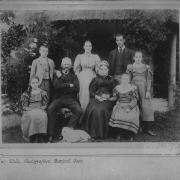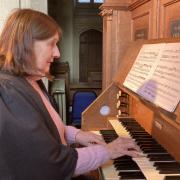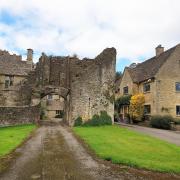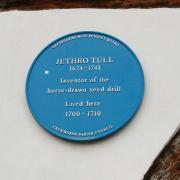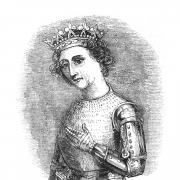A pioneering industrialist, manufacturer, engineer and aircraft designer, Frederick Handley Page (1885-1962) did not have a double-barrelled name but was known as ‘Handley Page’ in the same way that Arthur Conan Doyle became ‘Conan Doyle’.
From humble Gloucestershire origins, he’d become an influential aviation expert who made a significant contribution during both world wars. In a career spanning over 60 years there’d be more than 60 aircraft types that bore his name.
Born in Cheltenham on November 15, 1885, Frederick was the second son of Frederick Joseph Page, a furniture maker by trade and member of the Plymouth Brethren, a nonconformist religion originating from Ireland which emphasised the primacy of the Bible as the only recognised authority for church doctrine and practice, and Ann Eliza née Handley, hence Fred’s middle name. There’s a Cheltenham Civic Society / Handley Page Association blue plaque at 3 King’s Road that marks the spot: ‘Sir Frederick Handley Page, Aviation Pioneer, Born Here, 15-11-1885’.

Educated at Cheltenham Grammar, Handley Page then hacked off his parents in 1902, aged 17, by heading down to London to study electrical engineering. The following year would see the first powered flight achieved (December 1903) courtesy of the Wright brothers in the US. Qualifying in 1906, Fred then became head designer at an electrical engineering company in south east London before joining the Royal Aeronautical Society (1907). Showing that he was something of a maverick, Handley Page was sacked from his employ for illicitly conducting experimental aviation work there without permission; it seems he’d developed a fascination with flying.
In 1909 Handley Page founded the firm of aeronautical engineers that was to bear his name, Handley Page Ltd, the first British aircraft manufacturing corporation, and a company that became renowned for its heavy aircraft such as the Handley Page O/400 and later the Halifax bomber and H.P. 42 airliner. In the first instance though his first aircraft was as far removed from a heavy bomber as could be; it was a glider. He was soon developing his first powered aircraft though, dubbed ‘Bluebird’, which had its brief maiden flight on May 26 1910. Handley Page himself tried to learn to fly using this, crashed, and the project was swiftly abandoned. Fred was earning additional money as a journo and lecturer while his company got off the ground (apologies). It was a time for pioneers in the air and they had to be daredevil too. The first Briton to die in a powered flight accident in July 1910 was Charles Rolls, the 32-year-old co-founder of Rolls-Royce who was piloting a Wright Flyer. By the time of the accident though the early supremacy of the Wright brothers was being challenged by a new crop of designers, Handley Page among them. There were others who’d also become household names, the likes of Junkers (Germany), Fokker (Holland), and Sikorsky (Russia), and a crop of Brits such as de Havilland, Sopwith and Hawker.

Shortly after WW1 began, Handley Page was invited to the Admiralty to discuss the Navy’s air requirements which resulted in a spec for a twin-engined bomber, which became the Handley Page O/100, the largest aircraft to date, which first took to the skies in December 1915, and was the first bomber capable of carrying a payload of 1,800 lbs of bombs. The Handley Page Company with this single craft had fashioned its reputation for building large planes. More would follow, namely the twin-engined O/400 of 1918, one of the first truly heavy bombers such that the man behind the Company became known as the ‘father of the heavy bomber’, and the four-engined O/1500 which was designed to reach Berlin with a payload of three tons but was never used in anger as the war ended before it could be utilised. Advances in military aviation were all very well but it was all a nasty foretaste of what was to come a generation later in WW2.
Between 1917-19 Handley Page was involved in experimentation with ‘leading-edge slots’ on wings which he developed to overcome fatal crashes due to stalls and spins. The ‘slot’ is an air gap between a small slat and the wing permitting wind to pass between the two and would be adopted by all RAF aircraft. He was working on the science at the same time as a German, Gustav Lachmann, the two men sharing patents in a new post-war spirit of reconciliation. Lachmann even joined Handley Page as its head of design and later director of research. Handley Page’s patent for a controllable device where slots could be opened and closed by the pilot was granted on October 24, 1919. During this period Handley Page had also got married, in 1918 to Una Thynne (1890-1957), a coupling that bestowed three daughters. He also had a nephew, Geoffrey Page (1920-2000) who’d become a Battle of Britain fighter ace.

The immediate post-war world was difficult for the aviation industry. It was a fledgling business in any case yet Handley Page Ltd had grown enormously from a dozen staff prior to the war to more than 5,000 come the end of it. The industry generally had been rapidly geared for wartime manufacture and now had tons of unwanted military aircraft, and Handley Page now looked to transition by utilising some of those craft with a subsidiary, ‘Handley Page Transport Ltd’ (1919); it was time for cargo rather than conflict. HP Airline flights were now heading to the likes of France, Belgium, Holland and Switzerland: It would later merge to become part of Imperial Airways, the UK’s first national airline and forerunner of today’s BA. A mainstay of Imperial was the H.P.42, one of which appeared at Brockworth Aerodrome (1932), a private charter for 32 drama critics heading to the Malvern Festival for the premier of George Bernard Shaw’s play Too Good To Be True; it does indeed sound too good to be true.
Handley Page also bid successfully for all the unwanted ‘stuff’ which it could use for spares, whilst converted aircraft were sold off for the new civil aviation industry. Another company, the imaginatively-named Aircraft Disposal Company, or ADC, was set up in 1920 for the purpose. It was also known, a bit more inventively as ‘Airdisco’; a party in the sky perchance. Handley Page Ltd was its sole agent which might have helped enormously with its own post-war recovery. It didn’t though. It proved to be a poisoned chalice, with shares in Handley Page Ltd plummeting in value until a bank bailout was needed in a scene rather reminiscent of some of the acquisitions in the wake of our more recent banking crisis; a sure bet sometimes turns out to be a share battering.

Come WW2 it was Handley Page’s Hampden, which took part in the first British raid on Berlin, and Halifax bombers that were very much to the fore as well as its transports, the Halifax being introduced in 1941 with over 6,000 of these aircraft being used during the war and some of them later being utilised as part of the Berlin Airlift (1948) as was another HP plane, the Hermes. Frederick Handley Page was knighted in 1942 for his contribution to the war effort. The Handley Page Victor B.2., a long-range medium bomber was deployed with RAF’s Bomber Command from 1962 when the service had moved to nuclear delivery (potentially) during the Cold War. As far as civil aircraft were concerned the Handley Page Hannibal, Hermes and Herald transport planes were much used.
Handley Page was President of the Royal Aeronautical Society (1945-47), was a key figure in the establishment of the College of Aeronautics, and would also later serve as Deputy Lieutenant (1954-56) and then Lieutenant of the County of Middlesex (1956-60) as well as holding other honorific titles. In 1960 Handley Page received the Albert Medal of the Royal Society of Arts (RSA) which was instituted in 1864 as a memorial to Prince Albert, who’d been a longstanding President of the Society. The medal is awarded for ‘distinguished merit in promoting Arts, Manufacturers and Commerce’. Orville Wright (of the Wright brothers) had been a past winner in 1917. Handley Page was also awarded the CBE.
Frederick Handley Page died on the late Queen’s birthday, April 21, 1962 in London, aged 76. There’s a blue plaque on the house in Grosvenor Square. Twenty-five years later he was inducted into the International Air & Space Hall of Fame.
CHRONOLOGY
1885 – Birth of Frederick Handley Page (November 15) in Cheltenham.
1909 – Founds Handley Page Ltd, the first British aircraft manufacturing corporation.
1915 – The first Handley Page Type O biplane bombers are produced during WW1.
1918 – Marries Una Thynne, the couple going on to have three daughters.
1919 – Handley Page Transport Ltd established as the firm transitions to the post-war world.
1932 – A planeload of theatre critics arrives at Brockworth Aerodrome (Glos) in an H.P.42.
1941 – Introduction of the Halifax during WW2. Over 6,000 would fly during the war.
1942 – Frederick Handley Page knighted for his contribution to the war effort.
1948 – Handley Page Halifax and Hermes aircraft used during the Berlin Airlift.
1962 – Death of Sir Frederick Handley Page (April 21) in London, aged 76.
References
Chambers Biographical Dictionary (1974)
The Wright Brothers (I. Mackersey, 2003)
Open Plaques (openplaques.org)
Britannica (britannica.com)
City, University of London (125-anniversary.city.ac.uk)
London Remembers (londonremembers.com)
Royal Aeronautical Society (aerosociety.com)
Pate’s Community (community.patesgs.org)
San Diego Air & Space Museum (sandiegoairandspace.org)
St Albans Museums (stalbansmuseums.org.uk)
Cranfield University (cranfield.ac.uk)














